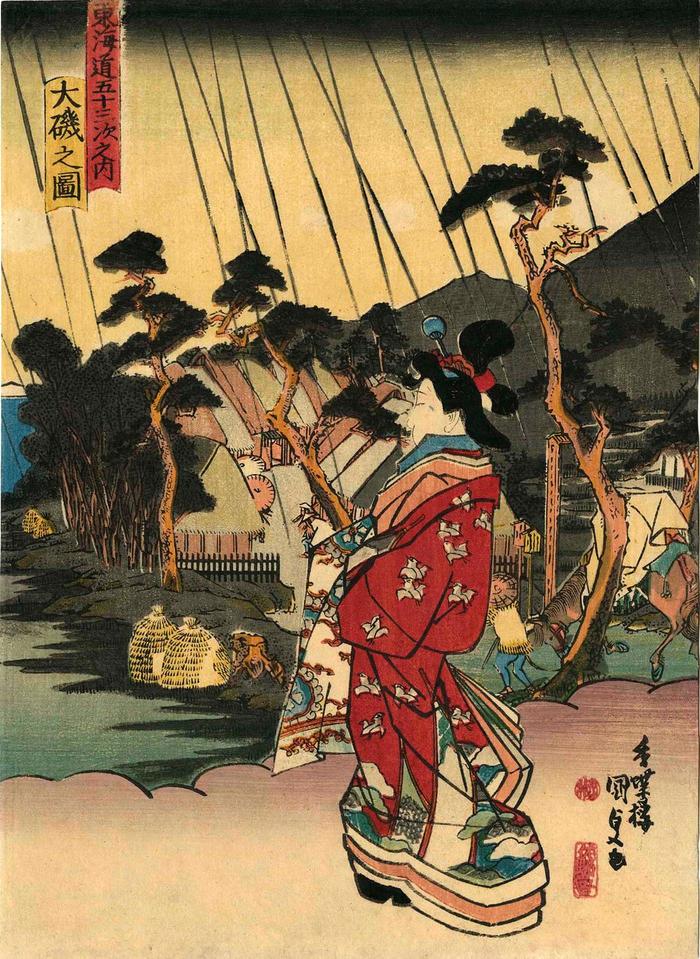Utagawa Kunisada (歌川国貞) / Toyokuni III (三代豊国) (artist 1786 – 01/12/1865)
View of Ōiso (Ōiso no zu: 大磯之図) from the series Fifty-three Stations of the Tōkaidō Road (Tōkaidō gojūsan tsugi no uchi: 東海道五十三次之内)
ca 1838
Signed: Kōchōrō Kunisada (香蝶楼国貞)
Publisher: Sanoya Kihei
Censor's seal: kiwame
Museum of Fine Arts, Boston - published by Moriya Jihei
National Diet Library - published by both Moriya Jihei and Sanoya Kihei
British Museum - Hiroshige's 'Oiso tora no ame' version
Museum für angewandte Kunst, Vienna
Ishikawa Prefectural Museum of Art - they date their copy to 1836
Bryn Mawr
Honolulu Museum of Art -
The Spencer Museum of Art
Fujisawa Ukiyo-e Museum
Victoria and Albert Museum
Nelson-Atkins Museum of Art All of the prints in this series are chūban sized. The example of this print in the collection of the Museum of Fine Arts in Boston is 10 1/4 x 7 5/16 in. This one in the Lyon Collection is fractionally smaller because it has been trimmed slightly at the top and bottom and along the right side.
****
Ōiso is a little more than a mile and a half from Hiratsuka.
****
This is number nine in the series. The curatorial files from the Museum für angewandte Kunst in Vienna say: "The landscape is almost identical to that of the Hiroshige, only there is an additional mountain in the background. In the foreground a woman in a pink kimono and a magnificent belt (obi). Over her kimono she wears a red coat (uchikake) with fishing nets, clouds and birds." Note that the woman's outfit design is considerably different from that of the same figure in the collection in Vienna. In that one the fish netting is far more prominent.
****
In Tokaido Landscapes: The Path from Hiroshige to Contemporary Artists, 2011, #9, p. 21, speaking of the original Hiroshige print it says in a text by Sasaki Moritoshi: "Rainfall on May 28 of the lunar calendar is known as tora-ga-ame [虎が雨]. Soga Jūrō, famous from an ancient episode of revenge, was killed that day and the tears of his lover, an Ōiso courtesan name Toragozen, were said to have turned into rain. Hiroshige painted this scene of rain with that tale in mind. The setting of this scene is the eastern end of Ōiso station. The travelers lower their heads to avert the rain as they approach the town building ling in the road. Dark rain clouds fill the sky, evoking a gloomy mood, while the Pacific's glowing deep blue provides a pleasing contrast."
Did Kunisada intend the bijin to be Toragozen? Probably.
****
In Hiroshige: l'art du voyage, Paris, 2012, p. 61 they identify the hill rising to the far right as Mt. Kōrai, the same mountain as seen in another print in the Lyon Collection, #1675.
****
Illustrated:
1) in color in 原色浮世絵大百科事典 (Genshoku Ukiyoe Daihyakka Jiten), vol. 4, p. 109, #319.
2) in a small color reproduction in Kunisada's Tokaido: Riddles in Japanese Woodblock Prints by Andreas Marks, Hotei Publishing, 2013, page 64, T24-09.
Sanoya Kihei (佐野屋喜兵衛) (publisher)
landscape prints (fūkeiga 風景画) (genre)
beautiful woman picture (bijin-ga - 美人画) (genre)
